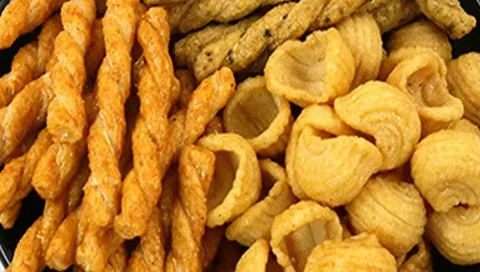Extruded snacks market growing with trends in health, innovation, diverse flavors, and regional expansion

The global extruded snacks market has experienced significant growth in recent years and is projected to continue expanding in the coming decade. Extruded snacks are processed foods made by forcing a dough-like mixture through a mold to create various shapes and textures, resulting in products such as puffed chips, pellets, and other snack items. This market's expansion is driven by several factors, including changing consumer preferences, urbanization, and increasing disposable incomes.
Market Size and Growth Projections
Estimates of the extruded snacks market's value vary among industry reports. According to industry projections, the market was valued at approximately $56.08 billion in 2023 and is projected to reach $91.81 billion by 2032, exhibiting a compound annual growth rate (CAGR) of 5.65% during the forecast period. Similarly, other reports suggest that the global extruded snacks market was valued at $61.97 billion in 2023 and anticipates it will hit $102.07 billion by 2032, with a CAGR of 5.7% from 2024 to 2032. These figures underscore the robust growth and potential within the extruded snacks sector.
Regional Insights
The Asia Pacific region holds a dominant position in the extruded snacks market. In 2023, it accounted for approximately 42% of the global market share. This dominance is attributed to the region's large population, urbanization, and the growing adoption of Western snacking habits. Additionally, North America is experiencing notable growth, driven by a shift toward healthier, high-protein, and gluten-free snack options. The increasing demand for convenient, on-the-go products aligns with busy lifestyles prevalent in the region.
Market Drivers
Several key factors are fueling the growth of the extruded snacks market:
-
Changing Consumer Preferences: There's a noticeable shift toward convenient, ready-to-eat snacks that fit into fast-paced lifestyles. Consumers are seeking products that offer both taste and convenience, leading to increased demand for extruded snacks.
-
Health and Wellness Trends: Modern consumers are more health-conscious, prompting a demand for snacks made from whole grains, legumes, and plant-based proteins. This trend has led manufacturers to innovate, offering products that are low in fat and high in fiber.
-
Product Innovation: To cater to diverse consumer tastes, manufacturers are introducing a variety of flavors, shapes, and textures. This continuous innovation keeps consumers engaged and drives market growth.
-
Urbanization and Busy Lifestyles: As urban populations grow and lifestyles become more hectic, the demand for convenient snack options that require minimal preparation continues to rise.
Distribution Channels
The distribution of extruded snacks spans various channels:
-
Supermarkets and Hypermarkets: These outlets offer a wide range of snack options, allowing consumers to compare brands and flavors easily. Their extensive reach makes them a dominant distribution channel for extruded snacks.
-
Convenience Stores: Located in easily accessible areas, convenience stores cater to consumers seeking quick snack options, contributing to the market's growth.
-
E-commerce Platforms: Online shopping provides consumers with the convenience of ordering snacks from home, often with a broader selection than physical stores. This channel is gaining traction, especially among younger consumers.
Competitive Landscape
The extruded snacks market is highly competitive, with numerous players striving to capture consumer attention through innovation and marketing. Major companies include PepsiCo, Calbee, ITC Limited, Kellogg Company, and Campbell Soup Company. These companies focus on product diversification, health-oriented snacks, and sustainable practices to meet evolving consumer demands.
Challenges and Opportunities
While the market presents substantial growth opportunities, it also faces challenges:
-
Health Concerns: Despite the trend toward healthier snacks, some extruded products are high in sodium and fats, raising health concerns among consumers. Addressing these issues requires reformulation and transparent labeling.
-
Raw Material Costs: Fluctuations in the prices of raw materials like wheat, corn, and rice can impact production costs and profit margins. Strategic sourcing and supply chain management are essential to mitigate these effects.
-
Sustainability: With growing environmental awareness, consumers and regulators are pushing for sustainable production practices and eco-friendly packaging. Companies that adopt such measures may gain a competitive edge.
Conclusion
The extruded snacks market is poised for continued growth, driven by evolving consumer preferences, health trends, and technological advancements in food processing. As manufacturers navigate challenges related to health perceptions and raw material costs, opportunities abound in product innovation, regional expansion, and sustainable practices. Staying attuned to consumer demands and market dynamics will be crucial for stakeholders aiming to succeed in this vibrant sector.
- Art
- Causes
- Crafts
- Dance
- Drinks
- Film
- Fitness
- Food
- Games
- Gardening
- Health
- Home
- Literature
- Music
- Networking
- Other
- Party
- Religion
- Shopping
- Sports
- Theater
- Wellness


